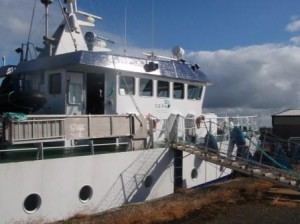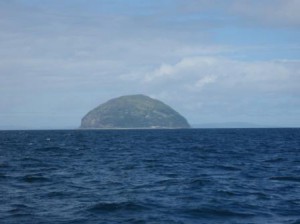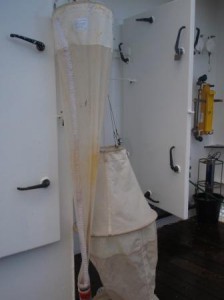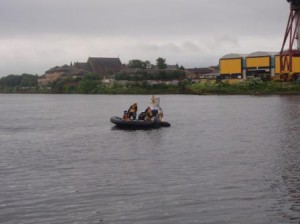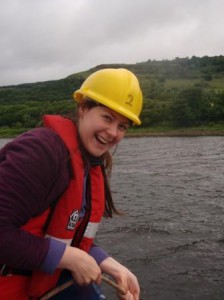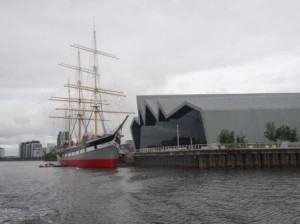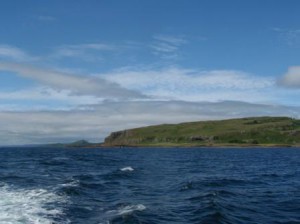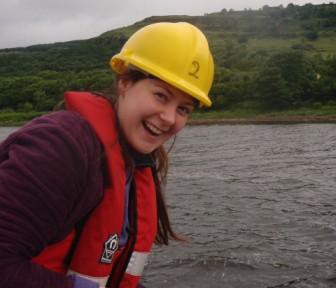
I have just returned from a brilliant trip around the Firth of Clyde on board SEPA’s marine research vessel the Sir John Murray. The Sir John Murray (SJM) is a 24 metre scientific vessel that is used for marine surveys year round, around the Scottish coast. She’s part of Scotland’s survey fleet and besides sampling for SEPA, does work for Scottish Natural Heritage and Marine Scotland too. The boat was named after the famous scientist Sir John Murray considered one of the founders of modern oceanography and set up the first marine laboratory in Britain, which went on to become the Scottish Association of Marine Science (SAMS).
Our trip began in Troon where the SJM is docked and headed out into the Firth of Clyde and south past Arran and Ailsa Craig to Loch Ryan on the southern limit of the Firth of Clyde. On this part of the trip I managed to catch a very fleeting glimpse of Britain’s largest fish the basking shark! – something I have been trying to spot for about 5 years! It was especially nice to see one now that I have begun to study zooplankton, the basking shark’s food. It’s amazing to consider these sharks can grow up to 10m long but they feed on tiny copepods that are only about 2mm in size.
The basking shark is listed as “vulnerable” on the IUCN red list of endangered species. This is mainly due a slow recovery from basking shark fisheries, which only ended in the UK in the 1990s. Although protected from fishing in the UK basking sharks undertake large migrations and have a circum-global distribution and so are still vulnerable from fisheries targeting sharks for their fins. Due to the basking shark’s feeding behaviour at the surface of the water (for which it was named) it is at risk from accidental bycatch from other fisheries and being hit by boats. Even if boats don’t hit sharks their presence could disturb and, therefore, affect basking shark behaviour. There are details of how to watch basking sharks responsibly in the Scottish Marine Wildlife Watching Code here: http://www.marinecode.org/documents/Guide-web.pdf
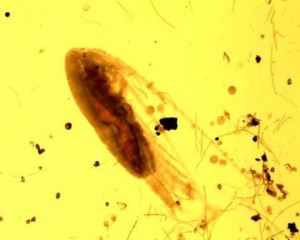
Calanus finmarchicus, only 2mm when fully grown like this male, note the reddish brown oil droplet inside its body that provides the energy for prey species like basking sharks
It was great to get out on the west coast and see some the sites that I have been analysing zooplankton samples from. As well as taking phytoplankton and zooplankton net samples we also collected water chemistry samples and took vertical profiles of water column using multi-parameter sondes. Sondes measure water temperature, salinity, chlorophyll, turbidity, pH and depth. These are used at sample stations to record characteristics of the water column when samples are taken but they are also left out for several months on a suite of buoys (SEPA’s National Marine Monitoring buoy network) to obtain data that covers a longer time period. During our trip we also replaced some of these with ones with fresh batteries.
After taking samples throughout the day we docked at Campbeltown for the night. The next day we set off and made our way to the northern part of the Firth of Clyde characterised by its many sea lochs. We took samples in Lochs Fyne, Striven and Long, unfortunately the weather was awful so couldn’t really see any of the scenery! At night we docked in Greenock and in the morning we made out way up the River Clyde to take some chemistry samples. Being from Glasgow it was great to see some of its famous landmarks from the river!
We then travelled back down the River Clyde, passed the Isles of Cumbrae and Little Cumbrae and back to Troon.Thank you so much to all the SJM crew – Hugh, Davie, Grant, Allan and Nick I had a great time and learnt loads!
To keep up to date with where the SJM is and has been sampling around Scotland click here:http://www.shipais.com/showship.php?mmsi=235019532
Sepa have just posted some great videos about their work in the Clyde. Click below to find out more about:
Water quality http://www.youtube.com/watch?v=PCGwMGuw2bU
Marine Science http://www.youtube.com/watch?v=gVAdz3kQT8c
Biodiversity http://www.youtube.com/watch?v=gVAdz3kQT8c

